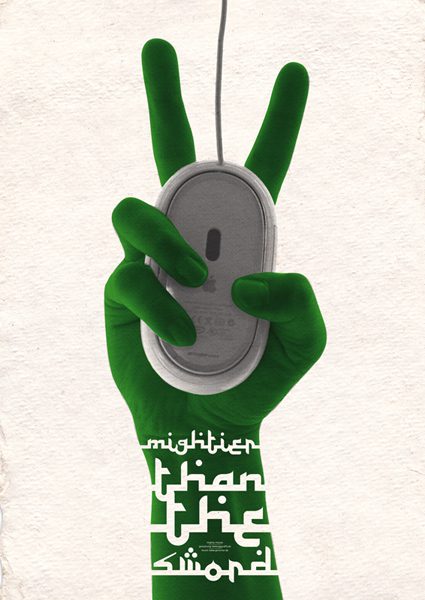
(Hilppa Hyrkas’ “Stop Climate Change,” Finland; Client: Friends of Earth Finland)
One of the best exhibitions of the year is running right now at FAU’s Ritter Art Gallery—and if the turnout during my visit this week is any indication, nobody is seeing it.
The touring exhibit “Graphic Advocacy: International Posters for the Digital Age 2001-2012” opened last week courtesy of FAU and curator Elizabeth Resnick of Massachusetts College of Art and Design. The generous sampling of 100-plus advocacy posters cuts across all cultures, topics and degrees, from the simple and subtle to the shocking and loud, and each is an example of what Resnick calls, in her curator’s statement, “dissent made visible.”
Created on computers instead of last century’s pencils, ink and graffiti, the works create a collective newsreel of the past decade’s most impactful global events, and they generally hang in clusters of thematic similarity: Income inequality here, Hurricane Katrina there, globing warming on a side wall. Rarely does a poster fail to engage the spectator; the only I one can think of that misses its mark is Robbie Conal’s “Patriot Inaction,” a grotesque polemic against George W. Bush that contains too much hyperbolic vitriol even for a dyed-in-the-wool leftie like me.

(Götz Gramlich’s “Mighty Mouse,” Germany; GGGrafik Design)
For the most part, the pictures speak a million words, embedding into your permanent memory—like Erin Wright’s “Death is Not Justice,” an anti-death penalty poster that envisions Christ not hanging on a cross but sentenced to the electric chair, the scales of justice dangling limply from one of his hands. Or Ben Stahl’s “Occupy,” which repurposes the font and colors of Shepard Fairey’s famous Barack Obama “Hope” poster, replacing the president with the sinister, revolutionary smile of Guy Fawkes. Or Mark Gowing’s “Oil Kills Peace,” in which a tar-black, birdlike blob plummets to its death against a spacious, all-white backdrop, like an agitprop Rorschach. (The plight of animals is an especially potent theme running through just about the entire show).

(Mark Gowing’s “Oil Kills Peace,” Australia)
What is noticeable from the get-go is the range of artists that have contributed these powerful messages. The bold, colorful, language-defying images spring from countries of first-world comforts to those suffering under dictatorial regimes, democratized by the egalitarian freedoms of the Internet. Through this medium, Iranians in the midst of the Green Revolution created artistic representations of their struggles in real time—as well as comment on other sources of injustice and tragedy across the globe. Compassion sprang instantaneously from all regions of the world. As this exhibition reveals, in the wake of the March 2011 tsunami that damaged the Fukushima power plant in Japan, graphic artists from South Korea, the U.S., Italy, Iran, Israel, Ecuador, Spain and the U.K. all created moving and/or disturbing images of the nuclear fallout. Much of the same global support followed in the aftermath of the Haiti earthquake of 2010.

(Oliver Soden’s “Japan Relief,” U.K.)
As political parties, religions and media mouthpieces continue to divide and conquer rather than unite us, “Graphic Advocacy” is a vital reminder that we’re all borne of the same matter, and when we see that something is wrong, we speak out—whether it originates in our locally corrupt seat of power or halfway across the earth. It also offers another powerful rebuke to the notion that millennials are an apathetic generation. Plenty of them are getting the word out in ways they never could before the adoption of digital technology; it’s up to us to receive the message. That means, first and foremost, getting a lot more visitors into the Ritter Art Gallery.
“Graphic Advocacy: International Posters for the Digital Age 2001-2012” runs through Oct. 25 at Ritter Art Gallery at FAU, 777 Glades Road, Boca Raton. Admission is free. For information, call 561/297-2661 or visit fau.edu/galleries.







